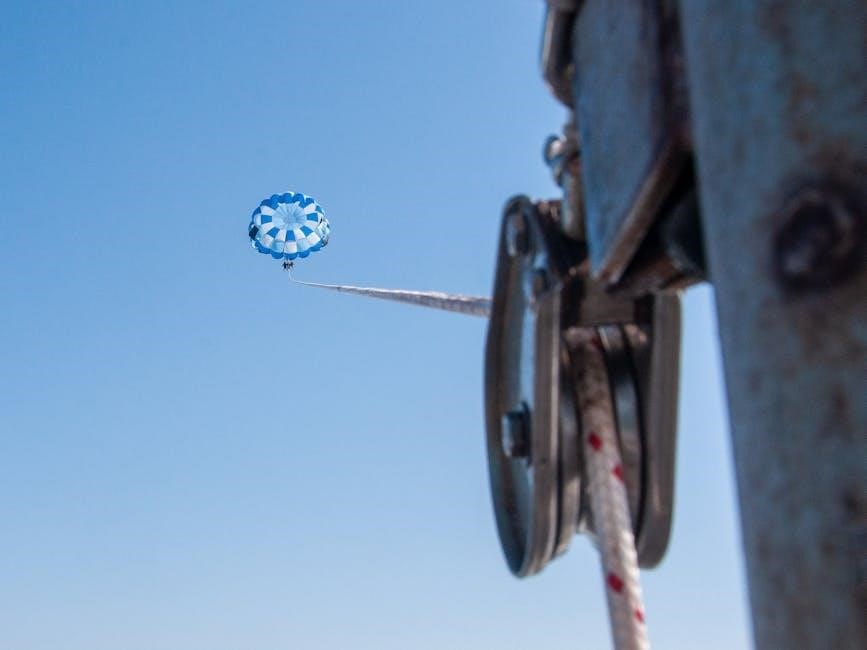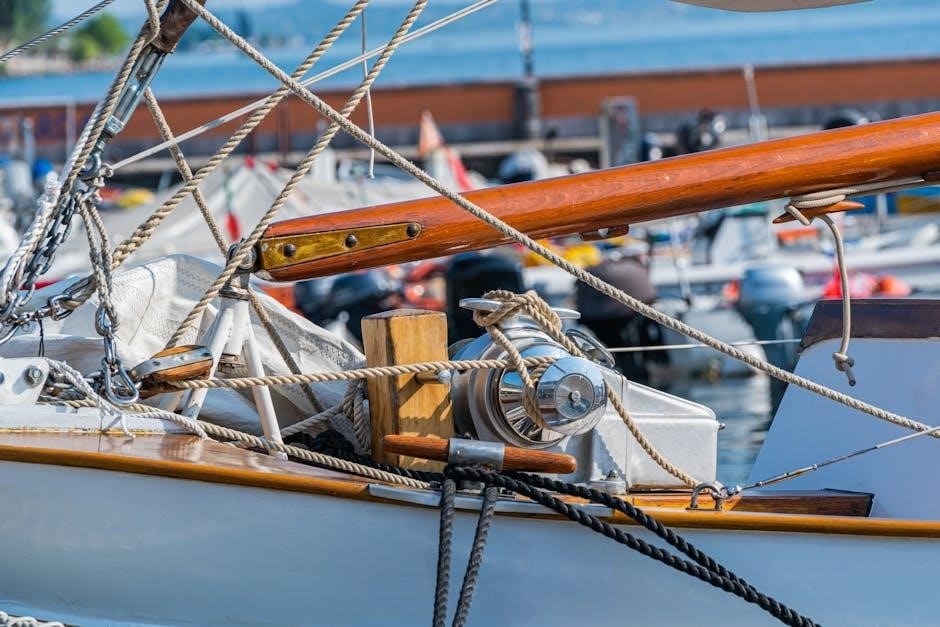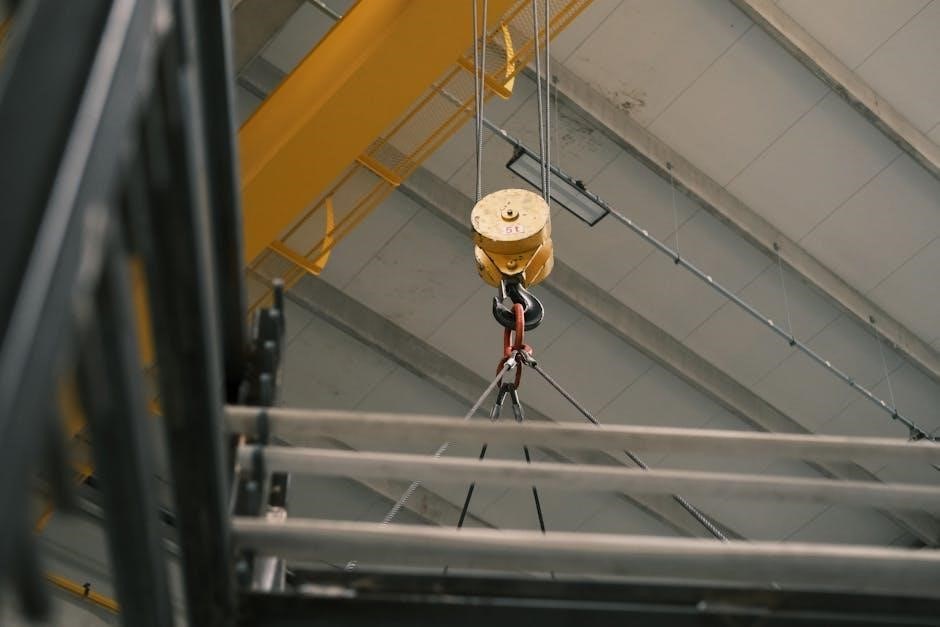Winch cable guide rollers are essential components that direct and manage the cable’s movement, ensuring smooth operation and preventing damage. They are crucial for proper cable spooling and alignment.
1.1 Definition and Purpose
Winch cable guide rollers are mechanical components designed to direct and support the movement of a winch cable, ensuring proper spooling and alignment. Their primary purpose is to guide the cable onto the winch drum, preventing tangling, kinking, or uneven winding. By maintaining consistent cable alignment, these rollers minimize wear and tear on both the cable and the winch system. They are essential for smooth operation, especially in high-stress applications like off-road vehicles or marine systems, where cable integrity is critical. Guide rollers also help prevent issues like “bird nesting” and ensure efficient, reliable winch performance.
1.2 Importance in Winch Systems
Winch cable guide rollers play a pivotal role in ensuring the efficiency and longevity of winch systems. They provide a smooth path for the cable to spool onto the drum, reducing friction and preventing wear. Properly aligned guide rollers minimize the risk of cable tangling, kinking, or uneven winding, which can lead to system failure. They are particularly crucial in high-stress environments, such as off-road vehicles or marine applications, where cable integrity is paramount. By maintaining consistent cable movement, guide rollers enhance overall system performance, reliability, and safety, making them an indispensable component in any winch setup.

Types of Winch Cable Guide Rollers
Winch cable guide rollers come in various designs, including roller fairleads, hawse fairleads, and custom or specialty rollers, each tailored for specific applications and cable management needs.
2.1 Roller Fairleads
Roller fairleads are durable, versatile components designed to guide winch cables smoothly onto the spool. They feature rounded rollers that reduce cable wear and prevent bird nesting. Often mounted close to the winch, they ensure proper alignment and minimize friction. Made from materials like stainless steel or aluminum, roller fairleads are ideal for various applications, including off-road vehicles and marine systems. Their design allows for easy installation and maintenance, making them a popular choice for both recreational and heavy-duty winching operations. Regular lubrication and inspection are recommended to ensure optimal performance and longevity.
2.2 Hawse Fairleads
Hawse fairleads are simple, durable guides designed to direct the winch cable onto the spool. Unlike roller fairleads, they typically feature a smooth, flat surface or a rounded groove. Hawse fairleads are often preferred for their robust construction and ability to handle heavy-duty applications. They are commonly used with steel cables and are ideal for harsh environments where durability is critical. While they may lack the smooth operation of rollers, their simplicity and strength make them a reliable choice for industrial and heavy-duty winch systems. Regular inspection is essential to ensure optimal performance and cable longevity.
2.3 Custom and Specialty Guide Rollers
Custom and specialty guide rollers are tailored to meet specific winching needs, offering unique features for particular applications. These rollers can be designed with specialized materials or coatings to resist corrosion or extreme temperatures. Some models include integrated tensioners or anti-kink mechanisms to prevent cable damage. They are often used in niche industries or for unique setups where standard rollers are insufficient. For example, marine environments may require rollers with enhanced corrosion resistance, while heavy-duty industrial applications might need rollers with reinforced structures. These customized solutions ensure optimal performance and durability in demanding conditions, making them a valuable investment for specialized winch systems;

Materials Used in Winch Cable Guide Rollers
Winch cable guide rollers are made from durable materials like stainless steel, aluminum, and synthetic composites. These materials ensure strength, corrosion resistance, and smooth cable operation.

3.1 Stainless Steel Rollers
Stainless steel rollers are a popular choice for winch cable guide systems due to their exceptional durability and resistance to corrosion. These rollers are often used in harsh environments, such as marine or outdoor applications, where exposure to moisture and rust is a concern. Constructed from high-grade stainless steel, they provide a smooth surface for the cable to glide over, reducing friction and wear. Their strength ensures long-lasting performance, even under heavy loads. Stainless steel rollers are also low maintenance, making them a practical option for various winch setups. They are ideal for applications requiring reliability and longevity.
3.2 Aluminum Rollers
Aluminum rollers are a lightweight yet durable option for winch cable guide systems. Known for their corrosion resistance, they are ideal for marine and outdoor applications. Aluminum rollers are often used in winch setups where weight reduction is a priority, such as on boats or off-road vehicles. They provide a smooth surface for cable movement, minimizing friction and wear. While not as heavy-duty as stainless steel, aluminum rollers are cost-effective and easy to install. Their corrosion-resistant properties make them a popular choice for environments exposed to saltwater or moisture, ensuring reliable performance over time. They are versatile and suitable for moderate to heavy-duty winch systems.
3.3 Synthetic and Composite Materials
Synthetic and composite materials are increasingly used for winch cable guide rollers due to their high durability and resistance to harsh environments. These materials, such as high-density polymers, offer excellent corrosion resistance and require minimal maintenance. They are lightweight, reducing overall system weight, and provide a smooth, low-friction surface for cable movement. Synthetic rollers are ideal for marine applications, where saltwater and moisture can degrade metal components. Composite materials also excel in extreme temperatures, maintaining their structural integrity. Their versatility and adaptability make them a popular choice for both industrial and recreational winch systems, ensuring long-lasting performance and reliability in diverse conditions.

Installation and Mounting
Proper installation and mounting ensure optimal performance. Mounting hole spacing, cable passage height, and alignment must be precise. Follow manufacturer guidelines for secure and effective setup.
Mounting hole spacing and dimensions are critical for secure installation. Ensure the roller’s mounting holes align with the winch or vehicle’s frame. Proper alignment prevents uneven stress and ensures smooth cable operation. Measure carefully to avoid misalignment. Use compatible hardware to fit the specified dimensions. Incorrect spacing can lead to loose fittings and operational issues. Always refer to the manufacturer’s specifications for precise measurements and hardware requirements. Accurate installation guarantees stability and longevity of the winch system. Proper fitting ensures efficient cable guiding and minimizes wear on components. Cable passage height and width are vital for smooth operation. Ensure the roller’s passage dimensions match the cable’s size to prevent pinching or rubbing. Proper clearance allows the cable to move freely, reducing wear and tear. Measure the cable’s diameter and compare it to the roller’s specifications. Adequate height and width ensure the cable glides effortlessly, minimizing friction. Incorrect dimensions can lead to cable damage or restricted movement. Always check the manufacturer’s recommendations for optimal sizing. Proper alignment and sizing ensure efficient cable routing and longevity of the winch system. This critical step prevents operational issues and enhances overall performance. Proper alignment of the cable guide roller ensures the cable moves smoothly and evenly onto the winch drum. Misalignment can cause uneven spooling, leading to cable wear and potential damage. Align the roller directly with the winch drum, maintaining consistent tension. Use mounting hardware that allows slight adjustments to achieve perfect positioning. Regular checks and adjustments are necessary, especially after installation or heavy use. Correct alignment prevents bird nesting and extends the lifespan of both the cable and the winch system. It also enhances operational efficiency and safety, ensuring reliable performance in all conditions. Proper setup is key to optimal functionality. Regular cleaning of the roller and fairlead is essential to remove dirt and debris. Lubricate all moving parts to reduce friction and wear. Inspect for signs of damage or excessive wear regularly. Cleaning the roller and fairlead ensures optimal performance by removing dirt, debris, and grime. Use a soft brush or cloth to wipe down surfaces. For stubborn dirt, mild soap and water can be effective. Avoid harsh chemicals that might damage materials. Regular cleaning prevents corrosion and extends the lifespan of components. It also reduces the risk of cable damage caused by sharp edges or debris buildup. A clean system ensures smooth cable movement and proper alignment. Always dry the parts thoroughly after cleaning to prevent rust or mineral deposits. This maintenance step is crucial for reliable winch operation. Lubricating moving parts of winch cable guide rollers is crucial for reducing friction and wear. Use a high-quality lubricant suitable for the material, such as silicone-based sprays for synthetic rollers or marine-grade grease for steel. Apply lubricant directly to pivot points or bushings, ensuring even coverage. For cables, apply a thin layer of lubricant along the length to minimize wear during operation. Avoid over-lubrication, as it can attract dirt and debris. Regular lubrication enhances smooth cable movement, prevents corrosion, and extends the lifespan of the roller and fairlead. This step is vital for maintaining optimal winch performance and reliability. Regular inspection of winch cable guide rollers is essential to identify wear and damage early. Check for cracks, frays, or excessive rust on the roller or fairlead. Look for uneven wear on the cable, which may indicate misalignment. Inspect pivot points for smooth movement and ensure no debris is trapped. Use a magnifying glass or flashlight to spot fine cracks or corrosion. If damage is found, replace worn parts immediately to prevent further issues. Inspect after heavy use or exposure to harsh conditions. This step ensures reliable operation and extends the lifespan of the winch system. Neglecting inspections can lead to costly repairs or safety hazards. Proper handling of winch cables prevents wear and bird nesting. Use gloves and avoid overloading. Regular inspections ensure safe operation. Always follow manufacturer guidelines. Always wear gloves to protect hands from sharp edges and abrasion. Keep the cable taut to prevent kinking and tangling. Avoid sudden jerks or overloading, which can cause breakage. Regularly inspect the cable for signs of wear or damage. Lubricate moving parts to reduce friction and extend lifespan. Ensure the roller fairlead is properly aligned to guide the cable smoothly. Never leave the cable loose or unattended during operation. Follow the manufacturer’s guidelines for load capacity and maintenance. Proper handling ensures safe and efficient winch performance. Proper cable alignment through the guide roller prevents uneven wear and tangling. Use a high-quality roller fairlead with a large diameter to reduce friction and extend cable life. Regular lubrication of moving parts minimizes heat buildup and wear. Inspect the cable and roller for signs of damage or misalignment. Avoid overloading the winch, as this can cause excessive stress on the cable. Ensure the cable is spooled evenly to prevent bird nesting. Proper maintenance and inspection routines help identify issues before they escalate, ensuring smooth operation and longevity of the winch system. Regular cleaning and lubrication are essential for optimal performance. In case of cable failure, immediately stop winch operation and secure the vehicle. Engage the winch’s free-spool mechanism to release tension. Inspect the cable for damage or breakage, wearing gloves to handle sharp ends. If the cable is damaged, do not attempt to reuse it without proper repair or replacement. Ensure the fairlead is clear of debris and functioning correctly. Replace the cable with a suitable alternative, ensuring compatibility with the winch system. Regular maintenance, including lubrication and inspection, helps prevent such failures. Always follow manufacturer guidelines for cable replacement and system operation to ensure safety and reliability. Winch cable guide rollers are used in off-road vehicles, marine systems, and industrial winches, ensuring smooth cable operation across diverse applications. In off-road and 4×4 vehicles, winch cable guide rollers are vital for reliable recovery operations. They ensure the cable spools evenly, preventing wear and bird nesting. Many ATVs and UTVs include roller fairleads in their winch kits to guide synthetic or steel cables effectively. Proper alignment is crucial for maintaining cable integrity during extreme pulls. The fairlead’s proximity to the winch drum maximizes cable life, while large-diameter rollers reduce friction and wear. This setup is essential for off-road enthusiasts, providing durability and efficiency in challenging terrains and recovery scenarios. In marine environments, winch cable guide rollers play a critical role in anchoring, towing, and lifting operations. They ensure smooth cable movement, preventing wear and damage from saltwater corrosion. Synthetic cables are often used in these systems due to their resistance to moisture and stretching. Roller fairleads and guide rollers are essential for maintaining proper cable alignment and tension, especially on sailboats and yachts. High-quality stainless steel rollers are preferred for their durability in corrosive marine conditions. Proper installation and maintenance of these components are vital to ensure reliable performance in demanding maritime applications. This enhances safety and operational efficiency at sea. In industrial settings, winch cable guide rollers are vital for handling heavy loads and ensuring precise cable control. These rollers are designed to withstand extreme stresses and constant use, often featuring large diameters to reduce wear on thick, heavy-duty cables. Synthetic and composite materials are commonly used for their durability and resistance to environmental factors. Proper alignment and regular maintenance are crucial to prevent cable misalignment and bird nesting. Industrial winches rely on robust guide rollers to maintain operational efficiency in manufacturing, construction, and material handling applications. Their reliability ensures safe and consistent performance in demanding environments. Choosing the right guide roller involves considering cable size, load capacity, and material compatibility. Stainless steel and synthetic options offer durability and resistance to environmental factors. Proper selection ensures optimal performance. Matching the guide roller to the cable size and type is crucial. For synthetic cables, rollers with smooth surfaces prevent abrasion, while steel cables require durable materials. Proper alignment ensures even spooling and reduces wear. Always check manufacturer specifications for compatibility to maximize efficiency and longevity of the winch system. Correct pairing enhances performance and prevents issues like bird nesting or cable damage. Ensuring the guide roller matches the winch’s load capacity is vital for safe and efficient operation. A roller designed for a higher load capacity can handle heavier weights without deforming, while a lower-rated roller may fail under stress. Compatibility with the winch’s specifications ensures smooth cable movement and prevents system overload. Always refer to the manufacturer’s guidelines to select a roller that aligns with the winch’s maximum capacity, promoting reliability and longevity of the entire winching setup. Proper matching enhances performance and reduces the risk of component failure during operation. Environmental factors significantly impact the performance and longevity of winch cable guide rollers. Corrosion-resistant materials, such as stainless steel or synthetic options, are ideal for marine or high-moisture applications. Extreme temperatures can affect the roller’s durability and functionality, with heat potentially degrading synthetic materials and cold causing metal brittleness. Selecting rollers designed for specific environmental conditions ensures optimal performance and minimizes wear. Proper material selection based on the operating environment is critical to maintaining reliability and extending the service life of the winch system. Always consider these factors during the selection process to ensure compatibility and durability. Identify and address issues like cable misalignment, uneven spooling, or roller sticking. Regular inspection and maintenance can prevent breakdowns and ensure smooth winch operation always. Cable misalignment occurs when the cable isn’t properly guided onto the spool, leading to uneven winding. This can cause inefficient winch operation and potential damage. Common causes include improper roller alignment, incorrect fairlead positioning, or excessive cable slack. Symptoms may include visible unevenness in the spool, increased wear on the cable, or noise during operation. To address this, ensure the guide roller is correctly aligned with the winch drum and the fairlead is centered. Regularly inspect and adjust the setup to maintain proper cable tracking and prevent uneven spooling. Proper maintenance can significantly reduce these issues. Noise and vibration during winch operation often result from misaligned or improperly maintained guide rollers. If the cable isn’t tracking smoothly, it can cause uneven wear and generate friction, leading to audible noise. Additionally, loose or worn components can exacerbate vibrations. Regular lubrication of moving parts and ensuring proper alignment of the guide roller can mitigate these issues. In severe cases, replacing worn rollers or adjusting the cable tension may be necessary. Proper maintenance and inspection are key to minimizing noise and vibration, ensuring efficient and quiet winch performance. Roller sticking or freezing occurs when debris, rust, or lack of lubrication hinders smooth rotation. Dirt and grime can accumulate, causing the roller to seize. Regular cleaning and lubrication are essential to prevent this. Inspect for corrosion or wear, as these can also contribute to sticking. Environmental factors like humidity or extreme temperatures may exacerbate the issue. Applying high-quality grease or silicone-based lubricants can restore mobility. If sticking persists, replacing the roller may be necessary. Proper maintenance ensures smooth operation and prevents damage to the winch system. Addressing the issue early avoids costly repairs and downtime. Winch cable guide rollers are indispensable for efficient and safe winch operations, ensuring proper cable management and minimizing wear. By selecting the right roller and maintaining it regularly, users can enhance system performance and longevity. Understanding the types, materials, and installation requirements helps optimize functionality. Regular lubrication and inspection prevent issues like sticking or freezing. Whether for off-road vehicles, marine applications, or industrial use, guide rollers play a vital role. Proper care and selection ensure reliable operation, making them a critical component in any winch system. Their versatility and importance cannot be overstated.4.1 Mounting Hole Spacing and Dimensions
4.2 Cable Passage Height and Width
4.3 Proper Alignment for Effective Cable Guide

Maintenance and Lubrication
5.1 Cleaning the Roller and Fairlead
5.2 Lubricating Moving Parts
5.3 Inspecting for Wear and Damage

Safety Considerations
6.1 Best Practices for Cable Handling
6.2 Avoiding Cable Wear and Bird Nesting
6.3 Emergency Procedures for Cable Failure

Applications of Winch Cable Guide Rollers
7;1 Off-Road and 4×4 Vehicles
7.2 Marine and Boating Winch Systems
7.3 Industrial and Heavy-Duty Winches

Selecting the Right Guide Roller
8.1 Cable Size and Type Compatibility
8.2 Load Capacity and Winch Compatibility
8.3 Environmental Factors (Corrosion, Temperature)

Troubleshooting Common Issues
9.1 Cable Misalignment and Uneven Spooling
9.2 Noise and Vibration During Operation
9.3 Roller Sticking or Freezing
